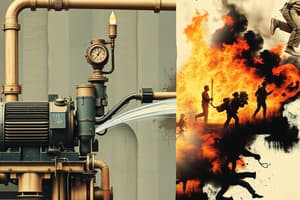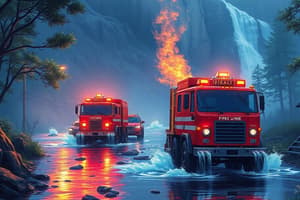Podcast
Questions and Answers
What is the purpose of hooking short (50') sections of 3in to the hydrant during reverse lay pump hook-ups?
What is the purpose of hooking short (50') sections of 3in to the hydrant during reverse lay pump hook-ups?
- To ensure maximum flow from the engine.
- To enhance the durability of the hoses.
- To minimize the friction loss of using 3in hose (correct)
- To increase water pressure from the hydrant.
Which connection is made to the 2 1/2" outlet on the hydrant during the hook-up?
Which connection is made to the 2 1/2" outlet on the hydrant during the hook-up?
- A short 50' section to the engine. (correct)
- An adapter for larger hoses.
- A 3" hose to maintain pressure.
- A 5" hose to increase flow.
Which of the following best describes why 3" hose is avoided on a forward lay
Which of the following best describes why 3" hose is avoided on a forward lay
- It does not conform to safety regulations.
- It is incompatible with the hydrant fittings.
- It has a higher friction loss affecting flow. (correct)
- It is harder to manage than larger hoses.
What type of adapter is used in this pump hook-up process?
What type of adapter is used in this pump hook-up process?
During the hook-up process, where should one hook up be connected?
During the hook-up process, where should one hook up be connected?
What is the primary effect of using a 2½" solid-bore tip at 80 psi nozzle pressure?
What is the primary effect of using a 2½" solid-bore tip at 80 psi nozzle pressure?
What is the effect of attaching a 2½"-5" Storz adapter to a hydrant?
What is the effect of attaching a 2½"-5" Storz adapter to a hydrant?
What is a key reason older apparatus might use a 2½" discharge to pump a 5" hose?
What is a key reason older apparatus might use a 2½" discharge to pump a 5" hose?
At what pressure does a 2½" solid-bore tip deliver 1000gpm?
At what pressure does a 2½" solid-bore tip deliver 1000gpm?
What issue was identified with the light blue 4 ½" - 4" adapter?
What issue was identified with the light blue 4 ½" - 4" adapter?
Which adapter is confirmed to work correctly?
Which adapter is confirmed to work correctly?
What action should be taken regarding the light blue adapters?
What action should be taken regarding the light blue adapters?
What is the correct designation for the thread type of the adapters?
What is the correct designation for the thread type of the adapters?
Why were some TFD apparatus equipped with bronze adapters initially?
Why were some TFD apparatus equipped with bronze adapters initially?
What is the primary consideration when a fire requires master streams?
What is the primary consideration when a fire requires master streams?
Which water supply method is preferred when the fire flow exceeds the capacity of two preconnects?
Which water supply method is preferred when the fire flow exceeds the capacity of two preconnects?
What issue can arise with hydrants in the city limits regarding steamer connections?
What issue can arise with hydrants in the city limits regarding steamer connections?
What is a major disadvantage of using 5" hose without a reverse lay when a strong water flow is needed?
What is a major disadvantage of using 5" hose without a reverse lay when a strong water flow is needed?
Which of the following is NOT a condition that may necessitate a reverse lay?
Which of the following is NOT a condition that may necessitate a reverse lay?
Why might mutual aid area hydrants present a challenge when connecting hoses?
Why might mutual aid area hydrants present a challenge when connecting hoses?
What is the friction loss in 5" hose at a flow rate of 1000 gpm?
What is the friction loss in 5" hose at a flow rate of 1000 gpm?
What is the implication of exceeding the distance of 300 feet to a hydrant when utilizing 3" supply lines?
What is the implication of exceeding the distance of 300 feet to a hydrant when utilizing 3" supply lines?
Flashcards
Water Supply System
Water Supply System
A system for providing water to firefighting operations, including both primary and secondary sources.
Friction Loss
Friction Loss
The loss of pressure in a hose due to friction as water flows through it.
Forward Lay
Forward Lay
A hose layout where the hose is extended from the pumper to the fire scene, with the nozzle at the end.
Reverse Lay
Reverse Lay
Signup and view all the flashcards
Master Stream
Master Stream
Signup and view all the flashcards
Pump Hook-Up
Pump Hook-Up
Signup and view all the flashcards
Tulsa Thread
Tulsa Thread
Signup and view all the flashcards
National Standard Thread (NST)
National Standard Thread (NST)
Signup and view all the flashcards
Steamer Outlet
Steamer Outlet
Signup and view all the flashcards
Hydrant-to-Storz Adapter
Hydrant-to-Storz Adapter
Signup and view all the flashcards
Forward Lay with 5' Hose
Forward Lay with 5' Hose
Signup and view all the flashcards
Reverse Lay and Pump Hook-Up
Reverse Lay and Pump Hook-Up
Signup and view all the flashcards
Solid-Bore Tip
Solid-Bore Tip
Signup and view all the flashcards
Reverse Lay Procedure
Reverse Lay Procedure
Signup and view all the flashcards
Short Lines for Pump Hook-Up
Short Lines for Pump Hook-Up
Signup and view all the flashcards
Light Blue Adapter
Light Blue Adapter
Signup and view all the flashcards
Bronze Adapters
Bronze Adapters
Signup and view all the flashcards
Improperly Manufactured Adapters
Improperly Manufactured Adapters
Signup and view all the flashcards
Inadequate Water Supply
Inadequate Water Supply
Signup and view all the flashcards
Relay Pumping
Relay Pumping
Signup and view all the flashcards
Forward Lay with 5' Hose
Forward Lay with 5' Hose
Signup and view all the flashcards
Hydrant Distance Beyond 300 Feet
Hydrant Distance Beyond 300 Feet
Signup and view all the flashcards
Study Notes
Water Supply Considerations
- Establish both primary and secondary water supplies for effective fire response.
- Friction loss for 5" hose at 1000 gpm is five to six psi per 100 ft, which does not guarantee a sufficient water supply on its own.
- Forward lays of 5" hose are suitable for most one and two-family homes, apartments, and small commercial fires.
- When master streams are anticipated, consider utilizing a reverse lay and pump hook-up for enhanced capability.
- A single 5” line configured with a reverse lay can supply multiple master streams and handlines.
- Reverse lay and pump hook-up is advisable when encountering:
- Weak hydrants or inadequate water supply
- Situations requiring relay pumping
- For anticipated fire flow exceeding the capacity of two preconnects or when hydrant distance surpasses 300 feet, avoid using 3" supply line.
Mutual Aid Water Supply
- Tulsa hydrants are outfitted with a 4" Tulsa Thread on the steamer outlet, while mutual aid areas utilize a 4 1/2" National Standard Thread (NST).
- Compatibility issues arise with steamer outlets but 2 1/2" NST outlets can be used with hydrant-to-Storz adapters.
- Instances of hydrants with non-compatible steamer outlets may require alternate water supply methods, such as forward lay with 5" hose or reverse lay and pump hook-up.
Strategic Hook-Up Techniques
- Forward Lay:
- Attach a 2½"-5" Storz adapter to one of the 2½" hydrant outlets.
- Operate a 5" supply line from the single 2 1/2" port to maintain flow to the scene.
- Solid-Bore Tip: Using a 2½" solid-bore tip can deliver 1000 gpm at 80 psi nozzle pressure, with minimal high friction loss due to the smaller outlet.
Hook-Up Steps
- Carry out the reverse lay procedure as standard.
- For pump hook-up:
- Connect two short (50') lines to the hydrant's 2 1/2" outlets.
- Attach one line to the nearest engine intake and the second line to the 5" master intake using a 2 1/2" to 5" adapter to reduce 3" hose usage and friction loss.
Light Blue Mutual Aid Removal
- Light blue 4 ½” NST – 4" Tulsa Thread adapters were improperly manufactured and do not work correctly with the steamer thread.
- Some Tulsa Fire Department (TFD) apparatus may have bronze adapters that fit correctly; these should be retained while light blue adapters must be returned to Physical Resources.
Studying That Suits You
Use AI to generate personalized quizzes and flashcards to suit your learning preferences.




